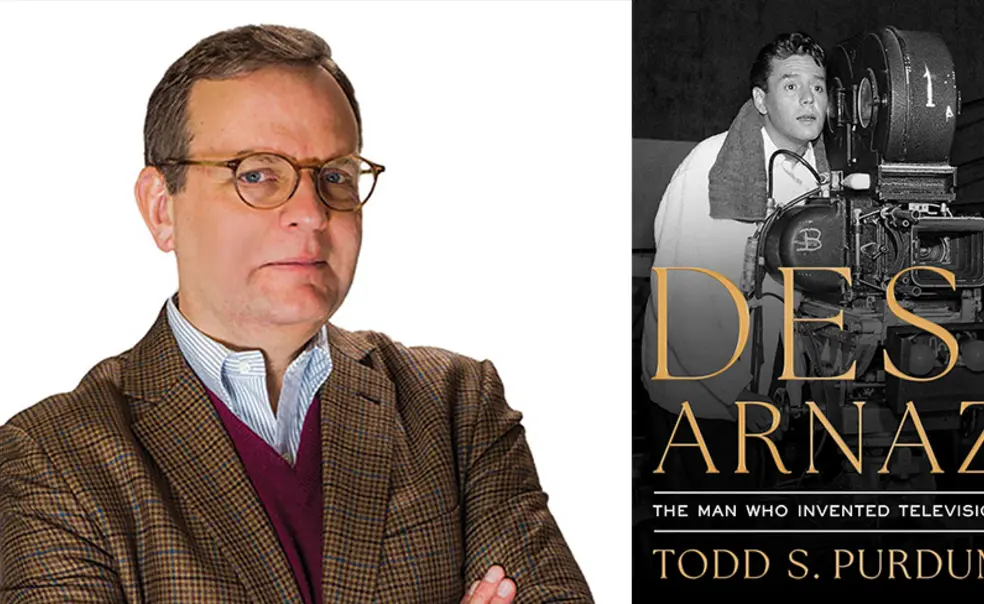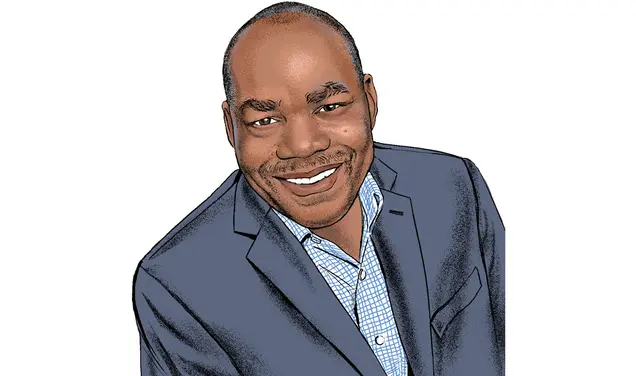Todd Purdum ’82 Chronicles Desi Arnaz’s Impact on Television
The book: This biography of Desi Arnaz, famous for his role in I Love Lucy, explores the Cuban American actor’s impact on the television industry. The story of Arnaz spans from devastation during the Cuban revolution to his contributions to Latin music in Miami, culminating in not only his beloved role as Ricky Ricardo but also his trailblazing behind the scenes in the television industry, which has helped shape sitcoms as we know them to this day. Containing unpublished interviews and supplemental materials, Desi Arnaz: The Man Who Invented Television (Simon & Schuster) is an expanded biography of Arnaz’s journey as an entertainer and entrepreneur, showing his tenacity and intelligence in a new light. This book solidifies Arnaz’s legacy as a cultural icon who brought joy and innovation to the entertainment industry.

The author: Todd S. Purdum ’82 is a journalist who worked at The New York Times for more than 20 years, where he was a White House correspondent. He is currently contributing editor at Vanity Fair and a senior writer at Politico. He is the author of several books including An Idea Whose Time Has Come: Two Presidents, Two Parties, and The Battle for the Civil Rights Act of 1964 and A Time of Our Choosing: America’s War on Iraq.
Excerpt:
Prologue
On Sunday evening, October 3, 1954, Ed Sullivan, the stone-faced New York newspaper columnist who had become perhaps the most awkward, unexpected television star, hosted a special celebration on his popular CBS program, Toast of the Town: a tribute to I Love Lucy, the network’s top-rated show, which was already a national institution on the eve of its fourth season on the air.
At a V-shaped banquet table bedecked with flowers, Sullivan had assembled a collection of celebrities — including Dusty Rhodes, the New York Giants outfielder who had just led his team to a World Series victory, and Howard Dietz, the lyricist of Broadway standards like “Dancing in the Dark” and “You and the Night and the Music” — to pay homage to the most beloved husband-and-wife team in contemporary entertainment, Lucille Ball and Desi Arnaz.
The evening’s roastmaster was a balding, avuncular, tuxedoed character named Tex O’Rourke, a onetime Texas Ranger, Wild West show performer, sports promoter, and boxing trainer who introduced Lucy and Desi as “two of my very favorite people, who have virtually dynamited their way into the hearts of all of us.” By this point, Lucille Ball needed no introduction to anyone, but O’Rourke nonetheless fancifully celebrated her as “the worst kind of redhead.” O’Rourke then turned to Arnaz, who was in fact the dominant force behind the scenes of I Love Lucy. “Down in the Caribbean, another hurricane was making up” one who “was born with a golden guitar in his lap, son of the alcalde of Santiago de Cuba, the biggest mansion in town, the biggest ranch in the hills, imported motor cars, a yacht.” Then came the revolution of 1933. “He was lucky to get out of the country, got over into Miami, a refugee, penniless… He hooked up with a fella who supplied canaries for the local drugstore.” At this, Arnaz covered his eyes in mock chagrin and demanded, “How did you find that out?” O’Rourke plowed on, “That’s my job, Desi. You might say he started at the bottom because his principal job was going around in the mornings and cleaning the birdcages. But in a way it was musical. They were singing canaries.”
O’Rourke then recounted Arnaz’s breakout as a Latin bandleader and how he and Lucy had met when Desi went to Hollywood to repeat his role as a South American football star in the film version of the Rodgers and Hart Broadway musical Too Many Girls. “From the start, it was a team through rough seas and smiling skies, but always a team,” O’Rourke said. “Sometimes a little bit hectic, but way down deep in their hearts they were always the kind of lovers that the whole world has got to love.”
When it was her turn to speak, Ball saved her warmest words for the man who, she knew better than anyone, had been most responsible for the show’s creation and for making her into one of the most famous women in the world. She and Desi had undertaken I Love Lucy at the lowest moment in their careers, when both had run out their string in the movies and were willing to leap into the still-untested, second-tier medium of television. Desi had persuaded a reluctant network and skeptical sponsor that the public would accept them — an unconventional, intermarried couple — as an all-American team. He had seen something in Lucy — and in the two of them together — that he knew would click with audiences. In personal terms, the show was also a determined attempt to save their marriage, after 10 years of frequent career conflicts that kept Desi on the road with his band, by allowing them to work together at last. Now they had triumphed beyond their wildest expectations and seemed to have everything.
“His name escapes me at the moment,” Ball deadpanned, “but this guy, who seems to be in all places at once, making like an actor, a banker, a politician — in short, a producer — gets my vote as the greatest producer of all time. And I have two little Arnazes at home to prove it.” At this she cast a sexy, heavy-lidded sidelong glance at her husband, the studio audience burst into supportive laughter, and Arnaz wiped his forehead with his pocket square. “Desi, I love you,” she said. “Signed, Lucy.”
Arnaz rose last, with an earnest intensity not at all like his character Ricky Ricardo’s so-often-exasperated mien. “Thank you, sweetheart,” he began. “Thank you, Ed. You know, if it wouldn’t have been for Lucy, I would have stopped trying a long time ago, because I was always the guy that didn’t fit.” He recounted his uphill battle to get the show on the air with himself as the co-star. “Finally, one executive at CBS said, ‘Well, maybe the audience would buy him, because after all they have been married…’?” Struggling to compose himself — his shoulders hunched, looking into the middle distance and not at the camera, barely holding back tears — he went on. “We came to this country, and we didn’t have a cent in our pockets. From cleaning canary cages to this night here in New York is a long ways. And I don’t think there’s any other country in the world that could give you that opportunity. I want to say thank you. Thank you, America. Thank you.”
Arnaz sat down with his head in his hands. Sullivan — a keen judge of talent who had known Desi for years and understood better than most the crucial role he had played in his wife’s success — cuffed him around the ear and drew him close in a fatherly embrace.
The gratitude that Desi Arnaz expressed that night was mutual, for against all the odds, white-bread, conformist, Eisenhower-era America had taken him and his unconventional alter ego to heart. He was adored as the man who loved Lucy, the combustible Cuban bandleader whose spluttering Spanish and long-suffering straight man’s frustration at the comic antics of his crazy wife softened into a loving embrace at the end of each episode. But Desi Arnaz was so much more than Ricky Ricardo. If Ball’s brilliant clowning — her beauty, her mimicry, her flexible face and fearless skill at physical comedy — was the artistic spark that animated I Love Lucy, Arnaz’s pioneering show-business acumen was the essential driving force behind it. He was, as NPR’s Planet Money once put it, the man who “invented television.”
“There’s a misconception that we — that Desi wasn’t all that important to the show,” Madelyn Pugh Davis, the founding cowriter of I Love Lucy, would recall years after his death. “And Desi was what made the show go. And he also knew that she was the tremendous talent. He knew that. But he was the driving force, and he was the one who held it together. People don’t seem to realize that.”
Today, nearly four decades after his death, Arnaz the performer remains a widely recognizable figure — “one of the great personalities of all time,” as his friend the dancer Ann Miller once put it. Much less well understood is the seminal role he played in the nascent years of television, helping to transform its production methods, and transforming himself, a successful but second-tier Latin bandleader, and his wife, a journeyman actress in mostly forgettable B movies, into cultural icons.
It was Arnaz (and I Love Lucy’s head writer and producer, Jess Oppenheimer) who assembled the world-class team of Hollywood technicians who figured out how to light and film the show in front of a live studio audience, with three cameras in sync at once — a then-pathbreaking method that soon became an industry standard for situation comedies that endures to this day. It was his ability to preserve those episodes on crystalline black-and-white 35-millimeter film stock that led to the invention of the rerun and later to the syndication of long-running series to secondary markets. This innovation also made it possible for the center of network television production to move from New York to Los Angeles and created the business model that lasted unchallenged for the better part of seven decades, until the streaming era established a competing paradigm.
“I Love Lucy was a crucial part of entertainment in this country,” said Norman Lear, the creator of the landmark situation comedy All in the Family and many other shows. “Lucy and Desi — I think it can be said they pretty much opened the door of Hollywood to America, and to the situation comedy. There was only one Lucy and one Desi, and between them, they knew what it took. He was a great businessman in the persona of a wonderful entertainer.”
It was Arnaz’s unselfconscious portrayal of the paterfamilias of an ethnically mixed family that proved a vivid contrast to the all-WASP lineup of contemporary sitcoms like Father Knows Best and Leave It to Beaver, and made him a breakthrough cultural figure in a country that would soon be transformed by growing social justice activism and a greater acceptance of diversity as a strength.
“In real life or fiction, neither Desi nor Ricky ever betrayed his Latino identity,” the columnist Miguel Perez would write in the New York Daily News after Arnaz’s death. “When Americans saw him on the screen in the 1950s, and when the world sees him now and in the future, they will not see Arnaz playing one of those criminal or drug-dealer roles usually given to Latinos. They see him as the head of an American family who, in spite of his accent and Cuban quirks, is realizing the Latino-American dream.”
Finally, it was Arnaz whose name came first in Desilu, the production company that he and Ball founded, which became the largest producer of television content in the world in the late 1950s; provided the studio space where many other shows, including those of Danny Thomas and Dick Van Dyke, were staged; and eventually spawned the global entertainment juggernauts Mission: Impossible and Star Trek.
Excerpted from Desi Arnaz: The Man Who Invented Television. Copyright © 2025 and published by Simon & Schuster. Reprinted with permission of the publisher.
Reviews:
"A scintillating biography of I Love Lucy costar Desi Arnaz. . . . A vividly rendered tale of a TV tycoon’s spectacular rise and ignominious fall." – Publishers Weekly
"Deeply researched and clear-eyed about Arnaz’s talents as well as his struggles. . . . Purdum gives us Arnaz’s life story, and it’s an often surprising one." — Ty Burr, The Washington Post












No responses yet